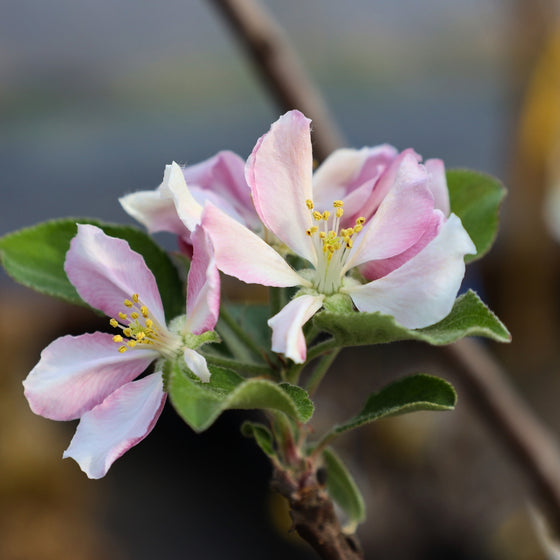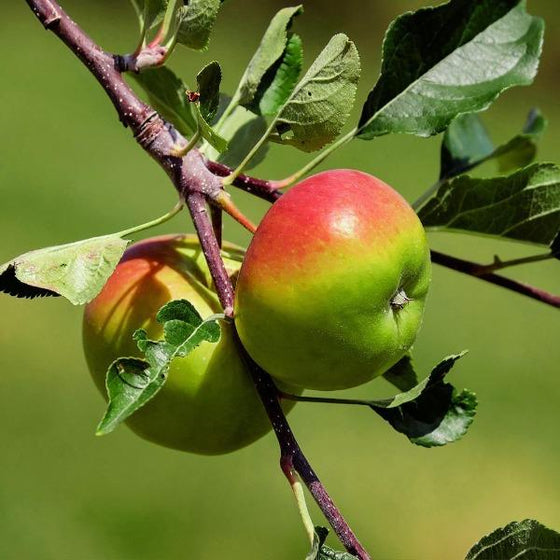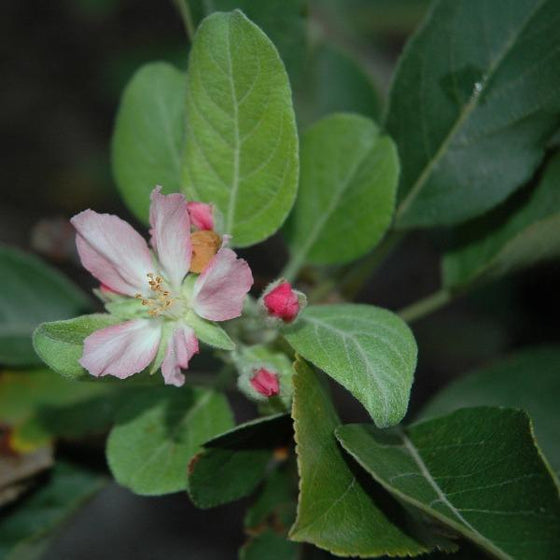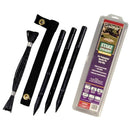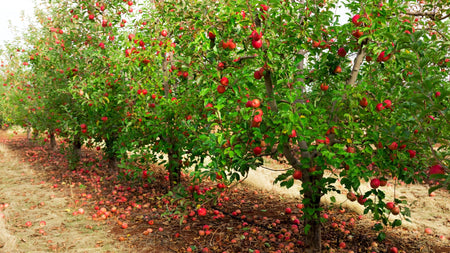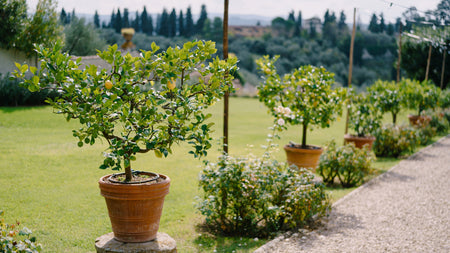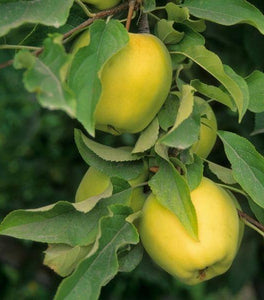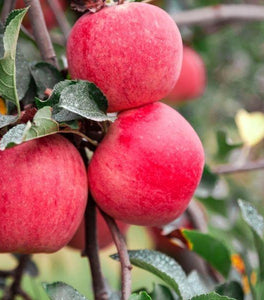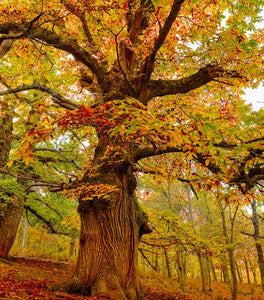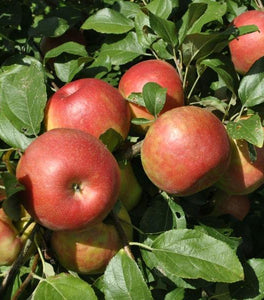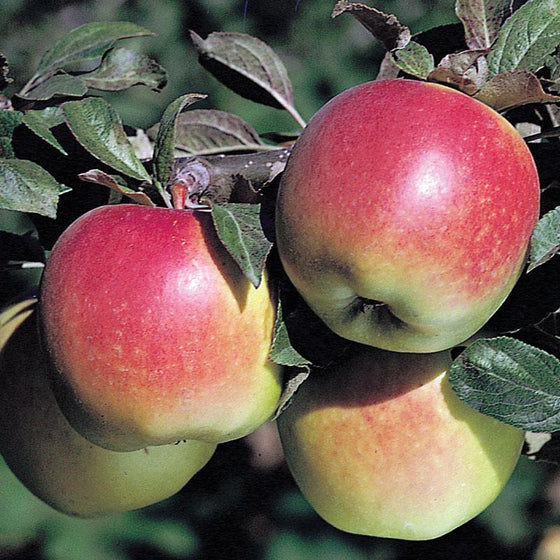
Images Depict Mature Plants
Anna Apple Trees
The Anna Apple Tree (Malus domestica 'Anna') is a popular, early-bearing apple variety prized for its crisp texture, sweet flavor, and adaptability to warm climates. Originally developed in Israel, this semi-dwarf apple tree is ideal for southern growers and performs exceptionally well in USDA Zones 5–9, especially in areas with mild winters and hot summers. Anna Apples are bright red with a slight green blush and have a flavor and texture similar to 'Red Delicious'—making them perfect for fresh eating, baking, and juicing. This low-chill variety requires just 200–300 chill hours, making it a standout performer in regions where traditional apple trees struggle.
The Anna Apple Tree is a vigorous grower, reaching a mature height of 15 to 20 feet if left unpruned, though it can be easily maintained as a smaller tree through regular pruning. It begins bearing fruit at a young age, often producing its first apples within one to two years of planting. For best fruit production, it is recommended to plant Anna with a pollinator partner such as the Dorsett Golden Apple Tree or Ein Shemer Apple Tree, both of which bloom around the same time. With cross-pollination, you'll enjoy a more abundant harvest of juicy, flavorful apples from late spring to early summer.
Whether you're starting a home orchard or adding a productive centerpiece to your edible landscape, the Anna Apple Tree offers beauty, resilience, and a reliable harvest. Its showy spring blossoms attract pollinators, while the tree’s manageable size makes it suitable for backyard gardens and even large containers. Easy to grow and early to fruit, Anna Apples bring the satisfaction of homegrown fruit to climates where apples are traditionally difficult to grow. Choose the Anna Apple Tree for a delicious, heat-tolerant variety that thrives in your warm-weather orchard.

| Hardiness Zone: | 6-9 |
|---|---|
| Mature Height: | 15 to 20 Feet |
| Mature width: | 15 to 20 Feet |
| Classification: | Broad leaved deciduous tree, spring flowering |
| Sunlight: | Full sun |
| Habit: | Spreading, umbrella shaped canopy |
| Foliage: | Dark green |
| Fruit Color: | Bright yellow with red blush |
| Pruning Season: | Late winter |
| Soil Condition: | Any well drained soil |
| Water Requirement: | Water well until established |
| Uses: | One of the best apples for eating fresh or storing |
How to Care for Anna Apple Tree
Before you buy an Anna Apple Tree, make sure to read about the recommended care instructions to keep this plant healthy and thriving.
How do I plant an Anna Apple Tree?
To plant an Anna Apple Tree, begin by selecting a location that receives full sun, ideally at least 6–8 hours of direct sunlight per day, to support healthy growth and optimal fruit production. The tree prefers well-drained, loamy soil with a slightly acidic to neutral pH (between 6.0 and 7.0). Dig a hole twice as wide and just as deep as the root ball or container. Gently loosen the roots before placing the tree in the hole, making sure the graft union (the swollen area near the base of the trunk) remains a few inches above the soil line. Backfill the hole with native soil, tamp lightly, and water deeply to eliminate air pockets and settle the soil. After planting, apply a 2- to 3-inch layer of organic mulch around the base of the tree, keeping it a few inches away from the trunk to prevent rot. This helps retain soil moisture and suppress weeds. Water the tree deeply once or twice a week during its first growing season to establish a strong root system, especially in hot or dry climates. Space Anna Apple Trees 15–20 feet apart from other trees or structures to allow room for mature growth and airflow. For best fruit set, plant it near a compatible pollinator such as a Dorsett Golden or Ein Shemer Apple Tree or even a Second Anna Apple Tree. With proper planting and care, your Anna Apple Tree will thrive and provide delicious, early-season apples for years to come.
How do I water my Anna Apple Trees?
Watering your Anna Apple Tree properly is essential for establishing strong roots and promoting healthy growth, especially during the first few years after planting. In the initial growing season, water deeply once or twice a week, depending on soil type and weather conditions. Aim to keep the soil consistently moist but not waterlogged, especially during hot or dry spells. A slow, deep watering at the base of the tree encourages the roots to grow deeper and become more drought-tolerant over time. Using a soaker hose or drip irrigation system helps deliver water directly to the root zone and reduces the risk of disease by keeping the foliage dry. Once established, Anna Apple Trees become more drought-tolerant but still require regular watering during extended dry periods or during fruit development. During the growing season, especially when the tree is flowering and forming apples, monitor soil moisture closely and water when the top few inches of soil feel dry. Applying a 2–3 inch layer of mulch around the base helps retain soil moisture and regulate soil temperature. Avoid shallow, frequent watering, which can lead to weak root systems. With consistent and proper watering, your Anna Apple Tree will thrive and reward you with sweet, crisp apples in early summer.
How do I fertilize My Anna Apple Trees?
To fertilize your Anna Apple Tree effectively, start by applying a balanced fertilizer such as 10-10-10 in early spring as new growth begins. This provides essential nutrients for root development, foliage growth, and fruit production. Spread the fertilizer evenly around the drip line of the tree—about 12 to 18 inches from the trunk for young trees—and water it in thoroughly to help the nutrients reach the root zone. For organic options, compost or well-aged manure can be worked into the soil to improve structure and provide slow-release nourishment. Avoid placing fertilizer directly against the trunk to prevent burning the bark. For young trees, apply fertilizer once in early spring and again in early summer to support vigorous growth. Once your Anna Apple Tree is established and begins fruiting, a single spring feeding is usually sufficient. Be cautious not to over-fertilize, as excessive nitrogen can encourage leafy growth at the expense of fruit production. If your tree shows signs of nutrient deficiency—such as yellowing leaves or stunted growth—you may consider a soil test to determine specific needs. With proper fertilization and care, your Anna Apple Tree will produce healthy foliage, strong limbs, and a generous crop of sweet, early-season apples.

How and When Should I Prune my Anna Apple Tree?
Pruning your Anna Apple Tree is essential for promoting healthy growth, improving air circulation, and encouraging high-quality fruit production. The best time to prune is in late winter to early spring, just before new growth begins but after the risk of severe frost has passed. Begin by removing any dead, damaged, or diseased branches, followed by cutting out any crossing or inward-growing limbs that could hinder airflow or light penetration. Focus on maintaining an open, vase-shaped canopy that allows sunlight to reach all parts of the tree—crucial for flower bud formation and fruit ripening. As your Anna Apple Tree matures, annual pruning helps control its size, maintain a strong framework, and encourage the development of fruiting wood. Thin out overly vigorous vertical shoots (known as water sprouts) and prune back long branches to encourage lateral growth, where fruit typically forms. Avoid heavy summer pruning, as it can stress the tree and reduce next year’s yield. With consistent and thoughtful pruning, your Anna Apple Tree will remain productive, disease-resistant, and aesthetically pleasing, delivering crisp, flavorful apples year after year in warm-climate orchards or home landscapes.

